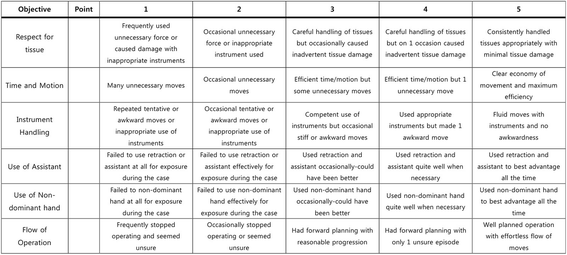The influence of prior laparoscopic experience on learning laparoendoscopic single site surgery: a prospective comparative preliminary study using cystorraphy in a live porcine model
- PMID: 28697805
- PMCID: PMC5506604
- DOI: 10.1186/s12894-017-0242-2
The influence of prior laparoscopic experience on learning laparoendoscopic single site surgery: a prospective comparative preliminary study using cystorraphy in a live porcine model
Abstract
Background: The purpose of this study is to assess the impact of prior laparoscopic experience on the ability to learn laparoendoscopic single site surgery (LESS) skills.
Methods: A total of 33 urologists who completed a training program in LESS surgery were recruited for this study. After completing the educational course and training, the study participants demonstrated LESS suturing and knot-tying via a 2-cm cystotomy in a live porcine model for 15 min. An objective structured assessment of technical skills (OSATS) was used to evaluate videos of each participant's procedure. The participants were divided according to laparoscopic experience; advanced experienced group (AS), intermediate experienced group (IS), novice group (NS).
Results: Three participants in the NS group completed the porcine cystorrhaphy in 15 min (30.0%), 3 (25.0%) completed the task in the IS group, and 3 (27.2%) completed it in the AS group. There were no statistically significant differences in the mean total OSATS quality score (NS; 16.7, IS; 18.5, AS; 16.8) among the 3 groups. Concerning all each assessment, there were also no statistically significant difference. Additionaly, the mean total OSATS quantity score (NS; 4.1, IS; 3.5, AS; 4.3) did not differ significantly among groups. The NS group succeeded a mean of 1.4 knots, the IS group succeeded 0.9, and the AS group 1.3 (p = 0.727).
Conclusions: There was no significant difference among the groups in LESS proficiency after training. Surgeons who were novices in conventional laparoscopic surgery reached comparable scores to those of experienced laparoscopic surgeons after training.
Keywords: Laparoscopic surgery; Learning curve; Minimally invasive surgery.
Conflict of interest statement
Ethics approval and consent to participate
This study was reviewed and approved by the Institutional Animal Care and Use Committee (IACUC) of Samsung Biomedical Research Institute (SBRI). SBRI is an Association for Assessment and Accreditation of Laboratory Animal Care International (AAALAC International) accredited facility and abide by the Institute of Laboratory Animal Resources (ILAR) guide.)
Consent for publication
Not applicable.
Competing interests
The authors declare that they have no competing interests.
Publisher’s Note
Springer Nature remains neutral with regard to jurisdictional claims in published maps and institutional affiliations.
Figures
Similar articles
-
Preliminary study of virtual reality and model simulation for learning laparoscopic suturing skills.J Urol. 2009 Sep;182(3):1018-25. doi: 10.1016/j.juro.2009.05.016. Epub 2009 Jul 18. J Urol. 2009. PMID: 19616797
-
Self-directed training with e-learning using the first-person perspective for laparoscopic suturing and knot tying: a randomised controlled trial : Learning from the surgeon's real perspective.Surg Endosc. 2020 Feb;34(2):869-879. doi: 10.1007/s00464-019-06842-7. Epub 2019 May 28. Surg Endosc. 2020. PMID: 31139998 Clinical Trial.
-
Developing an Objective Structured Assessment of Technical Skills for Laparoscopic Suturing and Intracorporeal Knot Tying.J Surg Educ. 2016 Mar-Apr;73(2):258-63. doi: 10.1016/j.jsurg.2015.10.006. Epub 2015 Nov 16. J Surg Educ. 2016. PMID: 26597729
-
Take-Home Training in Laparoscopy.Dan Med J. 2017 Apr;64(4):B5335. Dan Med J. 2017. PMID: 28385174 Review.
-
Are structured curriculums for laparoscopic training useful? A review of current literature.Curr Opin Urol. 2015 Mar;25(2):163-7. doi: 10.1097/MOU.0000000000000138. Curr Opin Urol. 2015. PMID: 25574792 Review.
Cited by
-
[The design and assessment of a novel simulated training system for cardiac surgery].Sheng Wu Yi Xue Gong Cheng Xue Za Zhi. 2018 Oct 25;35(5):779-785. doi: 10.7507/1001-5515.201712046. Sheng Wu Yi Xue Gong Cheng Xue Za Zhi. 2018. PMID: 30370719 Free PMC article. Chinese.
-
Single-Incision vs. Conventional Laparoscopic Surgery for Colorectal Cancer: An Update of a Systematic Review and Meta-Analysis.Front Surg. 2021 Aug 23;8:704986. doi: 10.3389/fsurg.2021.704986. eCollection 2021. Front Surg. 2021. PMID: 34497828 Free PMC article.
References
Publication types
MeSH terms
LinkOut - more resources
Full Text Sources
Other Literature Sources
Research Materials
Miscellaneous




